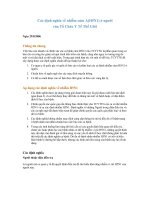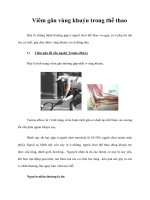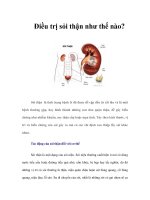CLEARING THE AIR docx
Bạn đang xem bản rút gọn của tài liệu. Xem và tải ngay bản đầy đủ của tài liệu tại đây (1.4 MB, 44 trang )
National Cancer Institute
Q U I T S M O K I N G
T O D AY
U.S. DEPARTMENT
OF HEALTH AND
HUMAN SERVICES
National Institutes
of Health 1
Table of Contents
Introduction 1
Before you START a Smoke-Free Life 2
Quitting is Hard 2
Preparing to Quit 3
Now Let’s START 12
Set a Quit Date 12
Anticipate and P
lan for the Challenges You Will
Tell your Family, Friends, and Coworkers You Plan to Quit 13
Face While Quitting
14
Remove Cigarettes and Other Tobacco Products from
Your Home, Car, and Workplace
16
Talk to Your Doctor about Getting Help to Quit
17
My Quitting Worksheet 19
Today’s the Big Day – Your Quit Date 21
Keep Busy and Find New ings to Do 21
Stay Away From What Tempts You 23
Plan to Reward Yourself 25
Quitting for Good – You Can Do It! 27
Keep Your Guard Up 27
Don’t Get Discouraged if You Slip 28
Stay Upbeat 29
Focus on a New, Healthier Lifestyle 30
Remember the Long-Term Rewards 32
For More Information 34
National Cancer Institute 34
American Cancer Society 35
American Heart Association 35
American Legacy Foundation 35
American Lung Association 36
Centers for Disease Control and Prevention 36
2
1
Introduction
From those of us at the National Cancer Institute:
Congratulations! You are taking the first step to
quitting cigarette smoking.
We wrote this booklet with the help of ex-smokers
and experts. It can help you prepare to quit and
support you in the days and weeks after you quit.
It also describes problems to expect when you
quit. Being prepared can help you through the
hard times.
Many tips are offered in this booklet—choose
what works best for you. Y
ou can quit for good,
even if you’ve tried before. In fact, most smokers
try to quit many times before they succeed.
Stay upbeat. Keep trying. Use what you learn each
step of the way until you quit for good. Soon, you
too will be an ex-smoker
.
The National Cancer Institute (NCI) is part of the National Institutes of
Health, one of 11 agencies in the U.S. Department of Health and Human
Services. NCI is the U.S. Government’s principal agency for cancer research
and training.
Before you
S
TART a Smoke-Free Life
Quitting is hard
Many ex-smokers say quitting was the hardest thing they ever did.
Do you feel hooked? You’re probably addicted to nicotine. Nicotine is in
all tobacco products. It makes you feel calm and satisfied, yet also alert
and focused. But the more you smoke, the more nicotine you need to
feel good. Soon, you don’t feel “normal” without nicotine. is is
nicotine addiction.
It takes time to break free from nicotine addiction. It may take more
than one tr
y to quit for good. So don’t give up too soon. You will feel
good again.
Quitting is also hard because smoking is a big part of your life. You may
enjo
y holding a cigarette and puffing on it. You may smoke when you
are stressed, bored, or angry. You may light up when you drink coffee or
alcohol, talk on the phone, drive, or are with other smokers. After months
and years, smoking has become part of your daily routine. You may light
up without even thinking about it.
Quitting isn’t easy. Just reading this booklet won’t do it. You may try to
quit several times before you’re finally done with cigarettes. But you will
learn something each time you try. It takes willpower and strength to beat
your addiction to nicotine. Remember that millions of people have quit
smoking for good. You can be one of them.
Just thinking about quitting may make you anxious. But your chances
will be better if you get ready first. Quitting works best when you’re
prepared.
2
Preparing to quit
Think about why you want to quit
Decide for sure that you want to quit, and then
promise yourself you’ll do it. It’s okay to have mixed
feelings. Don’t let that stop you. ere will be times
every day that you don’t feel like quitting. You will
have to stick with it anyway. Find reasons that are
important to you.
ink of health reasons, such as:
◆
My body will start healing right away.
◆
I will have more energy and focus.
◆
I will feel more physically fit.
◆
I will have whiter teeth and healthier gums.
◆
I will cough less and breathe easier.
◆
I will lower my risk of cancer, heart attack, stroke,
emphysema, chronic bronchitis, and cataracts.
◆
I will reduce the risk of fertility problems,
premature births, and lower birthweight babies.
◆
I will no longer expose my family and friends to
secondhand smoke.
KEEP IN MIND
Your body gets more
than nicotine when
you smoke.
Cigarette smoke
contains more than
4,000 chemicals. Some
of these chemicals are
also found in wood
varnish, the
insecticide DDT,
rat poison, and nail
polish remover.
The ashes, tar, gases,
and other poisons—
such as arsenic—in
cigarettes harm your
body over time. They
damage your heart
and lungs. They also
make it harder for
you to taste and smell
things and to fight
infection.
3
Source: U.S. Department of
Health and Human Services.
Reducing Tobacco Use:
A Report of the Surgeon
General. Atlanta, GA: U.S.
Department of Health and
Human Services, Centers
for Disease Control and
Prevention, National
Center for Chronic Disease
Prevention and Health
Promotion, Office on
Smoking and Health, 2000.
KEEP IN MIND
Even a little secondhand smoke is dangerous.
Secondhand smoke—also called environmental tobacco
smoke—comes from a burning tobacco product and from the
smoke exhaled by smokers. Inhaling secondhand smoke is
called involuntary or passive smoking.
Nonsmokers who breathe secondhand smoke may:
◆ develop cancer or heart disease
◆ have breathing problems
◆ get colds and the flu more easily
◆ die younger than people who don’t breathe
secondhand smoke
Pregnant women who breathe secondhand smoke may:
◆ give birth to low-weight babies
◆ have babies who are more likely to die of sudden infant
death syndrome (SIDS)
Children who breathe secondhand smoke may:
◆ have breathing problems, such as asthma
◆ get more ear infections
◆ develop more lung infections, such as pneumonia
Source: U.S. Department of Health and Human Services. The Health
Consequences of Involuntary Exposure to Tobacco Smoke: A Report of
the Surgeon General. Atlanta, GA: U.S. Department of Health and Human
Services, Centers for Disease Control and Prevention, Coordinating Center
for Health Promotion, National Center for Chronic Disease Prevention and
Health Promotion, Office on Smoking and Health, 2006.
4
_________________________________________________________________
_________________________________________________________________
_________________________________________________________________
_________________________________________________________________
_________________________________________________________________
_________________________________________________________________
_________________________________________________________________
_________________________________________________________________
ink of some other reasons to quit, such as:
◆
I will be proud of myself.
◆
I will make my family, friends, and coworkers
proud of me.
◆
I will be a better role model for others, especially
my kids.
◆
I will feel more in control of my life.
◆
I will have more money to spend.
◆
I will save time by not taking cigarette breaks,
buying cigarettes, or searching for a light.
Write down why you want to quit
Write down all the reasons you want to quit.
Keep your list where you’ll see it often. Good places
for your list are:
◆
where you keep your cigarettes
◆
in your wallet or purse
◆
in your kitchen
◆
in your car
When you reach for a cigarette, find your list of
reasons for quitting. It will remind you why
you want to stop.
My reasons to quit are
5
KEEP IN MIND
Pregnancy and smoking are not a good mix.
If you are pregnant or thinking about having a baby, there’s
no better time to quit smoking than now. Women who smoke
have a harder time getting pregnant. If they do get pregnant,
they risk losing the baby or having a stillborn baby. And
babies born to mothers who smoke:
may be smaller than normal at birth
are more likely to die of sudden infant death
syndrome (SIDS)
may be cranky, restless, and get sick more often
are more likely to have learning problems as they develop
The good news is that quitting can help you have a healthy
baby. It helps to quit any time during your pregnancy,
but it’s even better to quit before you become pregnant.
Information to help you stop smoking is available in English
and Spanish at www.smokefree.gov/resources.html.
Source: U.S. Department of Health and Human Services. Women and
Smoking: A Report of the Surgeon General. Atlanta, GA: U.S. Department of
Health and Human Services, Centers for Disease Control and Prevention,
National Center for Chronic Disease Prevention and Health Promotion,
Office on Smoking and Health, 2001.
◆
◆
◆
◆
6
1. How soon after you wake up do you Less than
smoke your first cigarette? 5 minutes
6–30 minutes
31–60 minutes
After 1 hour
2. Do you smoke more frequently in the
hours after waking than during the
rest of the day?
3. Do you find it difficult not to smoke? Yes
No
4. Which cigarettes would you most The first one in
hate to give up? the morning
Any other
5. How many cigarettes do you 10 or less
smoke a day?
Yes
No
11–20
21–30
31 or more
Yes
No
6. Do you smoke when you’re so sick
that you’re home in bed?
Learn how much you depend on nicotine
Knowing how addicted you are to nicotine can help
you quit. It can help you decide if you need extra
support, such as joining a quit-smoking program or
taking medication to help you quit.
Answer the six simple questions in this nicotine
addiction test.
Your score will help you figure out
how much you depend on nicotine.
Points Your
Points
3
2
1
0
1
0
1
0
0
Nicotine Addiction Test
1
0
1
2
3
1
0
Your Score
7
Understand what your score means
If you scored even a single point, you may be dependent
on nicotine. e higher your score, the more dependent
you are. Remember—no matter what your score, you’ll
have to work hard to quit.
Source: Heatherton, TF, Kozlowski LT, Frecker RC, Fagerstrom KO. The
Fagerstrom Test for Nicotine Dependence: a revision of the Fagerstrom
Tolerance Questionnaire. British Journal of Addictions. 1991; 86:1119–1127.
Understand what makes you want to smoke
Wanting to smoke is not just an unhealthy habit.
You want to smoke because your body now relies on
nicotine. When the amount of nicotine in your body
runs low, it triggers a craving—a strong, almost
uncontrollable urge—for another cigarette. You may
feel jittery, short-tempered, or anxious when you
haven’t smoked. Your body wants nicotine.
Triggers—people, places, activities, and feelings you
associate with smoking—also make y
ou want to
smoke. Your triggers might be hearing the sounds of
a party, finishing a task, or smelling coffee. Whatever
your triggers, they can make you crave a cigarette.
Know your triggers
If you know your triggers, you have a head start on
avoiding situations that tempt you to smoke.
ink about what might tempt you to smoke. Put a
check next to the triggers on page 9 that apply to you.
Many smokers find that all these triggers make them
want to smoke. You may only check a few. e point is
to recognize all the situations that trigger your craving
for a cigarette.
8
____________________________________________
____________________________________________
____________________________________________
____________________________________________
____________________________________________
____________________________________________
❑ Waking in the morning
❑ Drinking coffee, tea, or
alcohol
❑ Smelling a cigarette
❑
Being with other smokers
❑
Seeing someone smoke
❑
Taking a break
❑
Talking on the phone
❑
Checking email
❑
Surfing the Internet
❑
Watching TV
Meet your triggers head on
❑ Driving my car
❑
Being a passenger
❑
After eating
❑
After having sex
❑
After completing a task
❑
Feeling stressed
❑
Feeling lonely or depressed
❑
Being or feeling less tolerant
❑
Feeling bored
❑
Feeling angry, irritable,
or impatient
You can get prepared to quit smoking by thinking of ways to avoid some
triggers and cr
eating alternatives for others. You’ll find that the urge to
smoke only lasts a few minutes. Even if it lasts longer, it will go away,
whether or not you smoke. Fighting the urge to smoke is easier if you:
◆
take a deep breath
◆
keep your hands busy—write, doodle, or hold a coin or pencil
◆
put something else in your mouth, such as a toothpick,
sugar-free lollipop, or celery stick
◆
go places where smoking isn’t allowed, such as a library or
nonsmoking restaurant
◆
hang out with people who don’t smoke
◆
avoid or reduce alcoholic drinks; try to drink water or juice instead
I will deal with my triggers by
9
Know your options for quitting smoking
Quitting is hard. Success partly depends on how much you depend on
nicotine. With many quit methods to choose from, be aware that no
single approach works best for everyone. And you may need to try more
than one method before you quit for good.
Some quit methods require a doctor’s prescription. While others do not,
it’s always a good idea to discuss your plan to quit smoking with your
doctor. Check the box of the options you want to talk about with
your doctor.
❑
Cold turkey
For some smokers, “going cold turkey” seems like the easiest way to quit:
Just stop smoking and tell yourself you’ll never light up again. is
works for some smokers—usually those with the lowest level of nicotine
dependence—but not many. Fewer than 5 percent of smokers can
quit this way. Most people aren’t prepared when smoking habits and
withdrawal symptoms trigger an intense urge to smoke. Research shows
that most smokers have more success with one of the assisted quit
methods discussed below. ese methods have been tested and all of
them are included in the U.S. Public Health Service guidelines for
treating tobacco use and dependence.
❑
Over-the-counter medications
You don’t need a prescription to buy certain medications that can
improve your success with quitting. Nicotine replacement therapy (NRT)
products—lozenges, gum, or a patch—provide nicotine to help reduce
your craving for nicotine and withdrawal symptoms, if any. is allows
you to focus on changing the behavior and habits that trigger your urge to
smoke. To read more about NRT, see page 18.
10
❑
Prescription medications
Your doctor can prescribe medications to help you quit
smoking. Some—inhalers and nasal sprays—act much
like nonprescription nicotine replacement therapy.
Other medications do not contain nicotine and work
in different ways to help reduce your urge to smoke. To
read more about prescription medications, see page 18.
❑
Counseling and group support
Many smokers quit with support provided by individual
counseling or group treatment. You can combine
these therapies with over-the-counter or prescription
medications. Counseling can help you identify and
overcome situations that trigger the urge to smoke.
Research shows that success rates for all quit methods
are higher when they are combined with a support
program that provides encouragement through regularly
scheduled one-on-one or group meetings, or quitlines.
❑
Quitlines
Quitlines are free, telephone-based counseling programs
that are available nationwide. When you call a quitline,
you are teamed with a trained counselor who can help
you develop a strategy for quitting or help you stay
on the program you have chosen. e counselor often
provides material that can improve your chances of
quitting. You can call the National Cancer Institute’s
Smoking Quitline at 1–877–44U–Quit (1–877–448–
7848) or the National Quitline at 1–800–QUITNOW
(1–800–784–8669). ese are national quitlines that
can help you anywhere in the United States.
11
KEEP IN MIND
Not everyone has
feelings of withdrawal,
but many smokers do.
You may experience
one or many
symptoms of
withdrawal and they
may last for different
periods of time.
Common feelings of
smoking withdrawal
include:
feeling down, blue,
or depressed
feeling anxious,
nervous, or
restless
having trouble
thinking clearly
being unable
to sleep
feeling tired or
run down
feeling hungry or
gaining weight
◆
◆
◆
◆
◆
◆
Finding a time to quit isn’t easy. Any time can be a good
time to quit when you are ready to try. Some smokers
like to pick a day that is meaningful to them, such as:
KEEP IN MIND
Some smokers find
it difficult to quit at
certain times—
after a bad day or
personal loss,
during a crisis, or
at a stressful time,
such as a divorce.
Examine how you
view such times in
your life. Can you
afford to wait before
setting your quit
date?
◆
a birthday or wedding anniversary
◆
the first day of vacation
◆
New Year’s Day (January 1)
◆
Independence Day (July 4)
◆
World No Tobacco Day (May 31)
◆
e Great American Smokeout
(the third ursday of each November)
It doesn’t have to be a special day to quit. For many
people, today is the day
. You can choose any day to be
your quit day. When you are ready to take the first step
toward quitting, take it.
TART
et a quit date
TART
Now Let’s
S
S
START: Five important steps toward quitting for good
S Set a quit date
T Tell family, friends, and coworkers you plan to quit
A Anticipate and plan for the challenges you will
face while quitting
R Remove cigarettes and other tobacco products
from your home, car, and workplace
T Talk to your doctor about getting help to quit
My quit date is
______________
12
___________________
___________________
___________________
___________________
___________________
___________________
___________________
___________________
___________________
___________________
___________________
___________________
___________________
___________________
T
ell your family, friends, and coworkers you plan to quit
S ART
Quitting smoking is easier with the support of others.
Tell your family, friends, and coworkers you plan to
quit and how they can help you.
Some people like to have others ask them how things
are going, while some find it annoying. Tell the people
you care about exactly how they can help you. Here
are some ideas:
◆
Ask everyone to understand if you have a change in
mood; assure them it won’t last long.
◆
Ask smokers who are close to you to quit with you
or at least not smoke around you.
◆
Tell yourself and others: “e longer I go without
cigarettes, the sooner I’ll feel better.”
◆
Tell yourself and others: “e worst withdrawal
symptoms from smoking—irritability and trouble
sleeping—may be over within 2 weeks.”
In addition to the support of family, friends, and
coworkers, you can get support if you:
◆
talk one-on-one or in a group with others
who are quitting
◆
text-message experts on
LiveHelp at
www.smokefree.gov.
◆
call the National Cancer Institute Quitline at
1–877–44U–QUIT (1–877–448–7848)
◆
contact the National Quitline at
1–800–QUITNOW (1–800–784–8669)
The family, friends,
and coworkers
I want to tell are
13
ST RT
nticipate and plan for the challenges
you will face while quitting
A
Expecting challenges is an important part of getting ready to quit.
Quitting presents both short- and long-term challenges. You may need
different strategies for handling each.
Short-term challenges
Most people who have a hard time quitting and resume smoking do so in
the first 3 months after trying to quit. Difficulty quitting is often caused by
withdrawal symptoms—the physical discomfort smokers feel when they
give up nicotine. It is your body’s way of telling you it is learning to be
nicotine-free. ese feelings will go away in time.
Long-term challenges
Even as your physical withdrawal is decreasing, you may still be tempted
to smoke when you feel stressed or down. Although it’s a challenge to be
ready for these times, knowing that certain feelings can trigger a craving
to smoke will help you handle the tough times.
Smoking journal
To understand your short- and long-term challenges, start by examining your
smoking habits. Keeping a smoking journal can help you track how many
cigarettes you smoke a day and what you are doing when you light up.
Check for patterns in your smoking. You may find triggers you aren’t even
aware of. Perhaps cigarettes you smoke at certain times or circumstances
mean different things to you. Some may be more important than others.
Understanding what tempts you to smoke in the short and long term will
help you control the urge to smoke before it hits.
14
0 None
1 Just a little
2 Some
3 A lot
15
My Smoking Journal
Cigarette Time Craving Activity Who I Was Mood
Number of Day Level With
Example 10:45 3 At work Alone Stressed
1
2
3
4
5
6
7
8
9
10
11
12
13
14
15
16
17
18
19
20
You can copy the journal in this booklet or make your
own. Keep your journal with you so you can easily use
it. Be sure to record the time you smoke, where you
are, what you are doing, and what you are thinking or
feeling. Rate how much you want the cigarette each
time you smoke.
Try this activity for at least a few days, making sure
to record 1 day during the week and 1 day on the
weekend. You may even find that the time you take to
complete the journal helps you smoke less.
__________________________________________
__________________________________________
__________________________________________
__________________________________________
__________________________________________
__________________________________________
__________________________________________
STA
R
T
emove cigarettes and other tobacco products
from your home, car, and workplace
Getting rid of things that remind you of smoking also
will help you get ready to quit. You should:
◆
row away all your tobacco supplies (cigarettes,
lighters, matches, and ashtrays). Don’t forget to
check your drawers, coats, and bags.
KEEP IN MIND
All forms of tobacco
are harmful.
Tobacco products
and delivery methods
come in many forms.
However tobacco
is packaged or
delivered, it causes
disease and
addiction. Light or
low-tar cigarettes
are just as harmful as
regular cigarettes.
Clear your home, car,
and workplace of all
forms of tobacco.
◆
Make things clean and fresh in your home and
car and at work; for instance, clean your drapes,
carpets, and clothes.
◆
Have your teeth cleaned and remove those
nicotine stains.
Don’t save the “just in case” pack of cigarettes!
S
aving one pack just makes it easier to start
smoking again.
I can remove reminders of smoking by
16
alk to your doctor about getting
T
STAR
help to quit
It is important to tell your doctor when you are ready
to quit—especially if you are pregnant, thinking of
becoming pregnant, or have a serious medical
condition. Your doctor can help you connect with the
right resources to make your quit attempt successful.
Remember—quitting “cold turkey” isn’t your only
choice.
Make sure to let your doctor or pharmacist know
what medications y
ou are taking. Nicotine changes
how some drugs work. Your doctor may need to
adjust some of your medications after you quit.
You can learn more about medications before you
see y
our doctor from the summaries below and the
up-to-date medication guide at www.smokefree.gov/
quit-smoking/medicationguide.
Medications to help you quit
e Food and Drug Administration (FDA) has
approved nicotine and non-nicotine cessation
products to reduce withdrawal symptoms and the
urge to smoke. Studies show that these medications,
compared with trying to quit without them, can
double or triple your chances of quitting for good. You
will get the most benefit from these medications when
you follow the instructions completely. You should not
use any product that has not been tested and approved
by the FDA.
17
18
KEEP IN MIND
Medications alone
can’t do all the work.
They can help with
cravings and
withdrawal, but they
won’t completely
prevent withdrawal
symptoms. Even if
you use medication
to help you stop
smoking, quitting may
still be hard at times.
Many people find
it helps to combine
medication with
behavior strategies.
For example, you
can keep healthy
snacks handy to beat
cravings, limit time
with smokers, and
enroll in a smoking
cessation program.
Nicotine cessation products
Nicotine cessation products—also called nicotine
replacement therapy (NRT)—contain small amounts
of nicotine but not the hundreds of other harmful
chemicals found in cigarettes. NRT helps you handle
the physical symptoms of quitting by providing
nicotine at much lower levels than found in cigarettes.
is satisfies your nicotine craving and lessens your
urge to smoke. Over-the-counter NRT options
include a patch, gum, or lozenges that contain
nicotine. Nicotine inhalers and nasal sprays are
available only by prescription.
Non-nicotine cessation products
Some products that help withdrawal symptoms and
nicotine cravings don’t contain nicotine. ey help by
reducing symptoms and smoking urges. A prescription
is needed for these medications. See your physician to
discuss the details of your medication plan and to get a
prescription.
My next doctor’s appointment is
Date________________________Time_________________
_____________________________________________________
_____________________________________________________
_____________________________________________________
_____________________________________________________
_____________________________________________________
_____________________________________________________
_____________________________________________________
_____________________________________________________
_____________________________________________________
_____________________________________________________
My Quitting Worksheet
Review what you have done so far to prepare yourself to quit smoking
successfully.
My reasons to quit are
My nicotine addiction test score is
_______________________________
My triggers
❑ Waking in the morning
❑ Driving my car
❑ Drinking coffee, tea, or
❑ Being a passenger
alcohol
❑ After eating
❑ Smelling a cigarette
❑ After having sex
❑ Being with other smokers
❑ After completing a task
❑ Seeing someone smoke
❑ Feeling stressed
❑ Taking a break
❑ Feeling lonely or depressed
❑ Talking on the phone
❑ Being or feeling less tolerant
❑ Checking email
❑ Feeling bored
❑ Surfing the Internet
❑ Feeling angry, irritable,
❑ Watching TV
or impatient
I will deal with my triggers by
19
_____________________________________________________
_____________________________________________________
_____________________________________________________
_____________________________________________________
_____________________________________________________
_____________________________________________________
_____________________________________________________
_____________________________________________________
_____________________________________________________
_____________________________________________________
_____________________________________________________
_____________________________________________________
My Quitting Worksheet
The quit method I’m interested in
❑ Cold turkey
❑ Over-the-counter medication (gum, patch, lozenges)
❑ Prescription medication (inhaler, nasal spray)
❑ Counseling and group support
❑ Quitlines
My quit date is _______________________________________________
The family, friends, and coworkers I want to tell are
I can remove reminders of smoking by
My next doctor’s appointment is
Date
____________________________Time__________________________
20
Today’s the
B
ig Day–Your Quit Date
21
So today is the big day—your quit date. Quitting is not
easy, so to help you get through your first smoke-free
days, we suggest that you:
◆
keep busy and find new things to do
◆
stay away from what tempts you
◆
plan to reward yourself
Keep busy and find new things to do
Keep busy today, spending as much time as you can in
nonsmoking places. Create some new habits and mix
up your daily routine. Today and the days ahead will
be easier if you avoid things that remind you of
smoking. Remember—it’s harder to smoke if you are
keeping yourself busy and finding new things to do.
Here are some examples to get you started.
Go to nonsmoking places Be active
◆ gyms ◆ walk or run
◆ libraries ◆
take a bike ride
◆ malls ◆
go for a swim
◆ museums ◆
shoot hoops
◆
places of worship
◆
try a yoga class
◆
smoke-free restaurants









